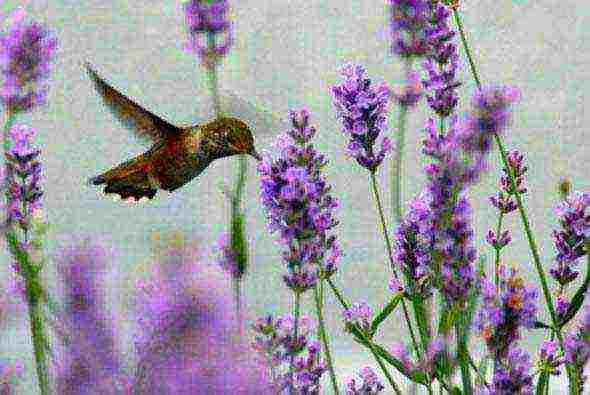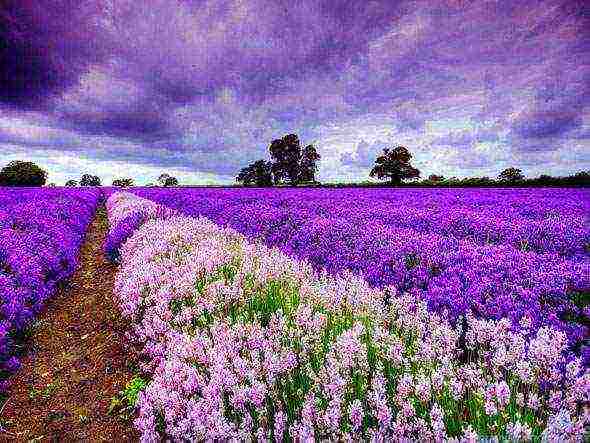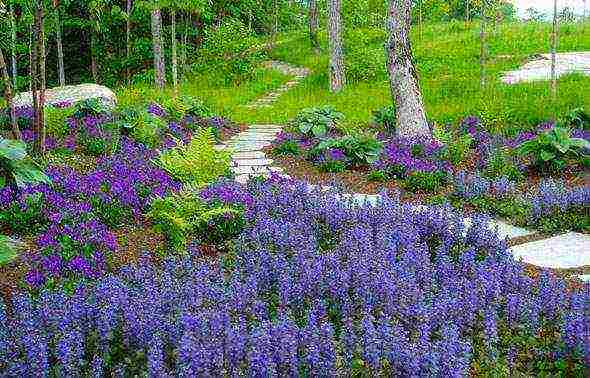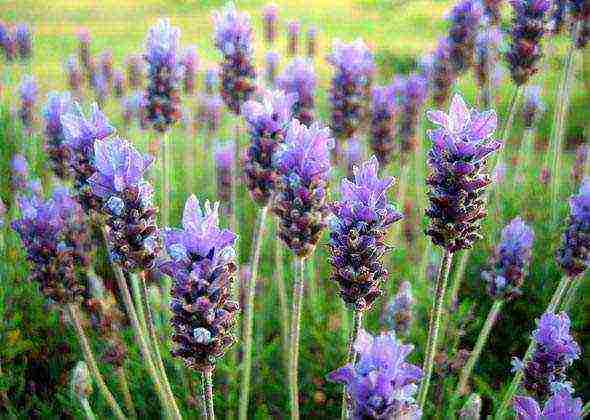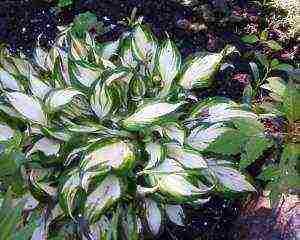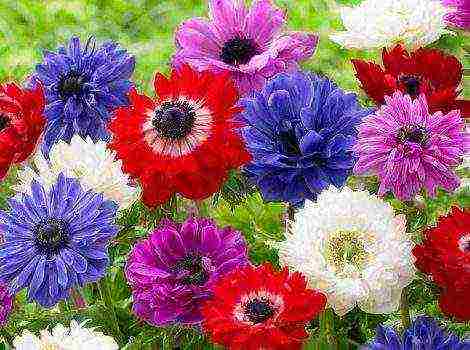Content
- 1 Landing place
- 2 Features of planting lavender
- 3 Sowing lavender seeds
- 4 Soil processing near bushes
- 5 Pruning lavender bushes
- 6 Fertilization
- 7 Preparing for winter
- 8 Types of lavender
- 9 The timing of planting lavender in the ground
- 10 Planting lavender seedlings in the ground
- 11 Planting lavender in the ground with cuttings, parts of a bush and layering
- 12 Taking care of lavender after planting outdoors
- 13 Description: varieties and varieties of lavender
- 14 Diseases and pests
- 15 Lavender: Combination with other plants
- 16 Lavender in landscape design
- 17 How to plant lavender correctly: video
- 18 Lavender in the garden: photo
Lavender
- a beautiful plant that conquers with its graceful, delicate aroma. She has gained wide popularity among gardeners for a very long time. Fluffy bushes of lavender, dazzling with bright inflorescences-spikelets - a great plant for borders,
alpine slides
and
rockeries
.

And you can learn about the beneficial properties of lavender from the article
"Lavender: beauty and benefit!"
.
Of course, to get a luxurious flower bed, you have to try. Lavender care is required on a regular basis. The complex of measures must include:
- loosening the soil;
- elimination of weeds;
- watering;
- pruning;
- fertilization;
- preparation for winter.
Lavender is a thermophilic plant. Therefore, to grow this
perennial
in the open field it is not possible in any climatic zone. In cold climates, the bushes should be planted in
flowerpots
and at the first hint of a cold snap, quickly transfer them to a warm place. Any variety of lavender can be grown as a pot plant.
Landing place
The key to successful
growing lavender - the right choice of landing site. Most of all, the plant will like open areas, well-lit by the sun's rays. The bushes will take root in the shade, but it will not be possible to achieve abundant and long flowering.
Plant roots are sensitive to high soil moisture levels. Therefore, you should refrain from planting lavender in wetlands and areas where they lie too high
groundwater
... If there is no other option, you can try to build a hill and plant bushes on it. Excess moisture near the roots can be easily removed with a drainage layer.

Any variety of lavender can be grown as a pot plant.
Lavender is also demanding about the level of acidity and soil structure. Therefore, if in doubt, it is better to play it safe - before boarding, deposit in
soil
a little woody
ash
or lime. These are effective soil deoxidizers. And to ensure the porous structure of the soil, it is enough to regularly apply to the garden
compost
... It will not only loosen the soil, but also supplement it with nutrients.
Features of planting lavender
Planting lavender - a responsible process. Adult bushes do not tolerate transplanting well, if you have to do it, then carefully and only with a voluminous lump of earth. It is better to immediately determine where the bushes grown from seeds, cuttings or cuttings will be located.
The distance between adjacent specimens should be approximately equal to their maximum height. Then the bushes will be lush. And to get slender green
hedges
we reduce this parameter by half. This way you can achieve the maximum solidity of the plantation block.

Lavender curbs are great Lavender cuttings take root pretty quickly. The planting algorithm is simple: deepen a couple of centimeters into a loose soil mixture, cover with a film and regularly moisten the soil. Gently dig out the rooted cuttings and transplant to the chosen place.
Layers are rooted branches of a plant.To obtain planting material, bend one of the lower shoots to the side in the spring. Fix the place of contact with the ground level and cover with soil. When a lump of roots forms, carefully cut off the cut with a sharp knife. Sprinkle the place of the cut with crushed coal to protect it from decay processes. That's it - the layering is ready for planting.
You can choose lavender seedlings of various varieties in our catalog, where various online stores present their products. Choose lavender seedlings
Sowing lavender seeds
Lavender is difficult to propagate by seed. But if it is not possible to purchase an adult plant or twigs, you can also try sowing seeds.
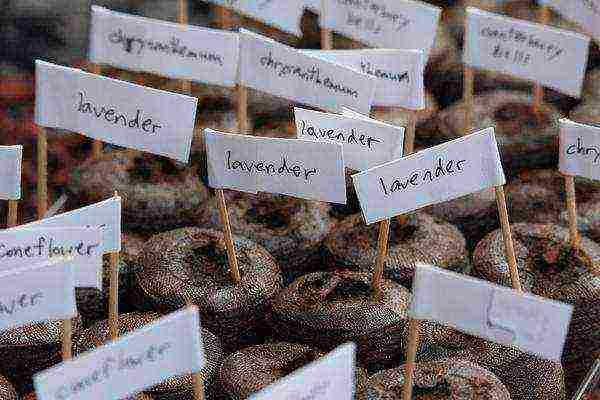
Lavender can be propagated by seed. A very important step is stratification. Lavender seeds need to be kept at low temperatures for some time. Here you can go in two ways: plant them at the end of autumn immediately in the ground or carry out artificial stratification. The first method is only suitable for warm climates. With significant frosts, seeds may die. Therefore, it is better to opt for the second option.
For artificial stratification, the seeds must be mixed with a small amount of sand, poured into a container, wrapped in polyethylene and refrigerated. Keep them there for at least a month and a half. Better - longer. In this case, seedlings will appear faster. Then you can sow seeds in boxes (at the end of winter) or in
greenhouses
outside (late spring).
When sowing with seeds, it will take a whole year to expect flowering. In the first seasons, seedlings will only develop, increasing the root system. And only after a year, and maybe even after two, they will delight the gardener with cute spikelets-inflorescences.
You can choose lavender seeds in our catalog, where products from various online stores are presented. Select lavender seeds
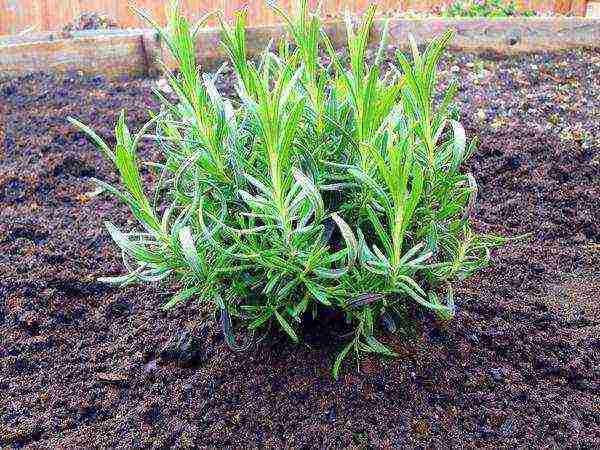
Lavender grown from seed will only flower for 2-3 years.
Soil processing near bushes
Lavender does not like dense soils. Its roots really need good air circulation. In addition, of course, you need to get rid of pest weeds next to lavender. Therefore, loosening and weeding should become a regular procedure.
You can do it easier - organize a good mulching layer on the lavender garden. As
mulch
you can use the decayed
foliage
or decorative multi-colored substrates. But in any case, near the base of the trunk, the soil should remain uncovered. This will keep the plant from rotting.
Water the lavender very carefully. Excessive irrigation can lead to root rot and yellowing of the aerial part of the plant. Drought is also bad for the plant - the lavender will not die, but the flowering will not be as luxurious as we would like. The ideal watering regime is as the soil dries up.
Pruning lavender bushes
This stage of lavender care cannot be called mandatory. But only by pruning can you achieve the formation of beautiful lush bushes. Therefore, you should not give up a useful procedure.

Pruning lavender The first pruning should be done immediately after the inflorescence spikelets wilt. You need to shorten the shoots literally by a couple of centimeters. At the end of the warm season, more drastic pruning is carried out. But here, too, you should not show excessive enthusiasm. If you shorten all the branches to the level of the lignified part, the bush may die.
Fertilization
Great as a fertilizer for lavender
mineral
complexes that are sold in all garden and flower shops. They should be applied during the beginning of flowering. Concentration - 2 tbsp. spoons in a bucket of water. With the resulting solution, you need to shed soil around the perimeter of the bushes.
Responsible for the development of green mass
nitrogen fertilizers
(2 tablespoons per bucket). Therefore, they are indispensable at the beginning of the growing season (growth). But in the second half of the summer, it is forbidden to use them.Under the influence of nitrogen, the growing season is significantly extended. As a result, the plant does not have time to prepare for wintering.
The use of fertilizers can be completely abandoned if there is a thick layer of compost mulch under the bushes. Decomposing under the influence of external factors, it will supply the plant with nutrients throughout the season.
Preparing for winter
For lavender bushes that have to spend the winter outdoors, you can organize a reliable
shelter
... True, in warm climatic zones, you can do without this - according to experts, lavender will survive the winter well, even if the temperature drops to -25 ° C. If frosts are expected to be stronger than this mark, insulation is necessary. In addition, it will not be superfluous to play it safe in cases when the winter may turn out to be little snow.
At the end of the season, lavender bushes are pruned. Branches are laid on top of the garden bed (best of all from conifers). But the usual insulation in the form of a layer of foliage is not suitable. Lavender can rot under it.
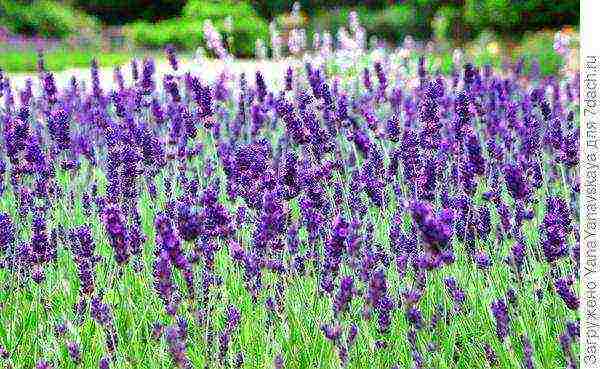
In general, caring for lavender is not as difficult as it might seem at first glance. Using compost mulch will eliminate weeding, loosening and top dressing. Therefore, the gardener will only have to cut the bushes in a timely manner so that they grow strong and bloom profusely.
The topical question "How to preserve lavender in winter" was asked by a reader of our site. You can read the tips and take part in the discussion.
Types of lavender
Many people associate lavender bushes with a constant purple color. In fact, shades of different varieties conquer with variety. There are specimens with blue, white, pink and even greenish colors. And this is just the basic palette. And the shades of inflorescences-spikelets are even more. But color is not the only difference between different lavender varieties.
According to the generally accepted classification, there are two broad groups:
english and
french .
English lavender - the owner of narrow leaves and elongated spikelets-inflorescences. It is worth noting that it is this type that has received the most widespread use. Such varieties winter quietly in the middle lane, without needing to be dug up in late autumn.
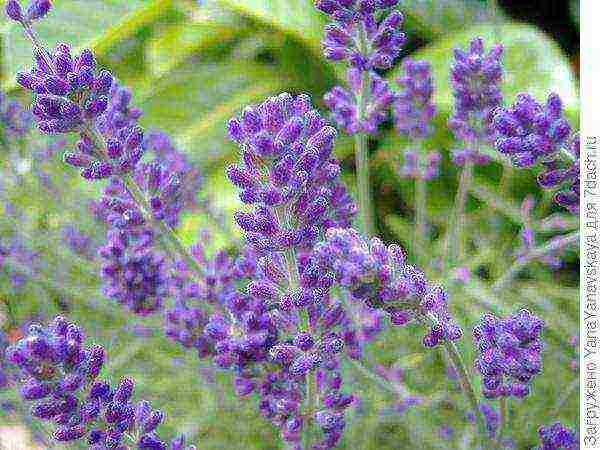
French lavender - a more capricious plant. Outwardly, it is similar to the previous species, but its leaves are wider, and the inflorescences are shorter. Traditionally used as a pot culture. After all, even minor frosts down to -15 ° C can instantly destroy the plant.
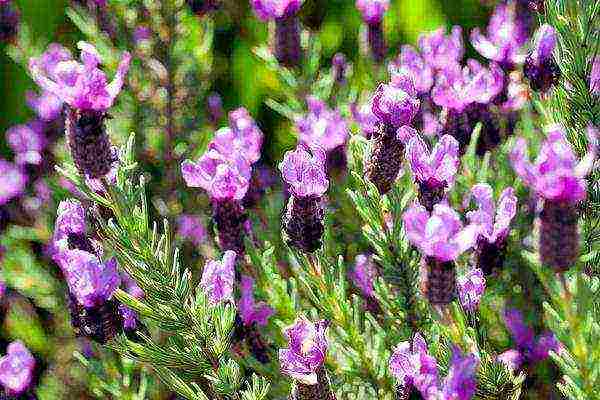
French lavenderAll articles about lavender on our website
 In the numerous family of Yasnotkovs, there are a lot of plants that have amazing decorativeness, an extraordinary aroma, and other useful properties. If the summer resident wants his site to be decorated with lavender, planting and care in the open field is a key moment on the path to success.
In the numerous family of Yasnotkovs, there are a lot of plants that have amazing decorativeness, an extraordinary aroma, and other useful properties. If the summer resident wants his site to be decorated with lavender, planting and care in the open field is a key moment on the path to success.
A perennial essential oil crop up to 60 cm high with spike-shaped blue or purple inflorescences has become a symbol of Provence. Lavender is grown in the Mediterranean, and in Russia it is planted in the Crimea and the Black Sea coast of the Caucasus.
Can a thermophilic plant take root in the middle lane? How to tame the culture of a gardener in Siberia or the Urals?
Among the plants related to lavender, there are many that, as a result of growing on personal plots, have completely assimilated, becoming part of the native flora. And some of them are well-known wild plants. These are motherwort and oregano, thyme and mint, catnip and lofant.
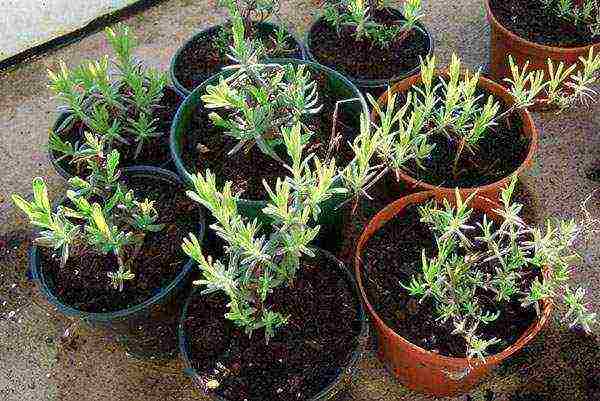 For the southern heat-loving beauty, the climatic conditions of our country are far from always comfortable. Still, planting lavender in the ground is possible. The main thing is to choose the right place, time and follow the rules of care.
For the southern heat-loving beauty, the climatic conditions of our country are far from always comfortable. Still, planting lavender in the ground is possible. The main thing is to choose the right place, time and follow the rules of care.
The timing of planting lavender in the ground
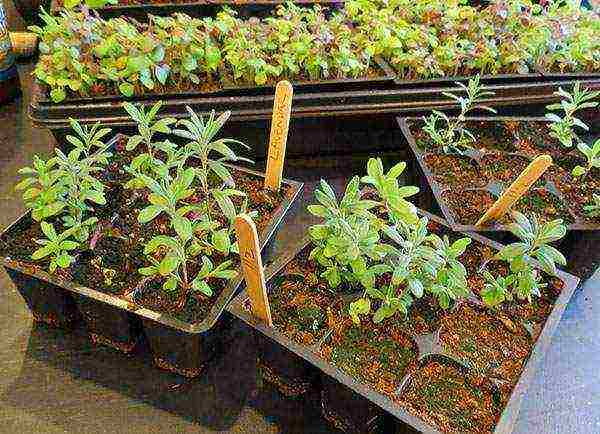
Of all the varieties of lavender, Lavandula angustifolia or narrow-leaved lavender is recognized as the most frost-resistant and unpretentious.
Under cover, it can survive frosts down to -35 ° C, which is quite comparable with winter temperatures not only in the central part of the country, but even in the Urals or Siberia.
Lavender propagates by seed and vegetatively using parts of an adult bush, rooted cuttings or cuttings.
In the first case, like many other decorative perennials:
- at home, medium-sized seeds are sown for seedlings in early spring;
- when stable heat comes, you can sow seeds in the beds;
- planting lavender in the ground in the fall is carried out to obtain plants for next year.
Vegetative reproduction helps to bring flowering closer. In this case, seedlings with their own root system fall into the soil in the second half of summer or autumn. Specific dates directly depend on climatic and weather conditions.
In the middle lane, planting and caring for lavender in open ground is subject to the rules common to all regions. The seeds should fall into the heated soil when the sprouts are not threatened by spring frosts. And before that, in order to accelerate germination, they are stratified in a refrigerator.
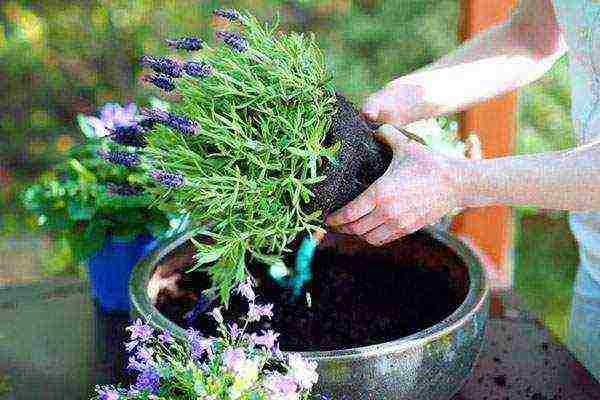 In the central part of Russia, such conditions for sowing develop by the second half of May. In the regions to the north and east, the soil warms up even later. Unfortunately our summer is short for lavender. Seedlings very often die without surviving the winter. Therefore, planting lavender in open ground in the Urals, for example, is preferable to seedlings obtained as a result of winter or early spring sowing, or seedlings obtained from an adult bush.
In the central part of Russia, such conditions for sowing develop by the second half of May. In the regions to the north and east, the soil warms up even later. Unfortunately our summer is short for lavender. Seedlings very often die without surviving the winter. Therefore, planting lavender in open ground in the Urals, for example, is preferable to seedlings obtained as a result of winter or early spring sowing, or seedlings obtained from an adult bush.
Planting lavender seedlings in the ground
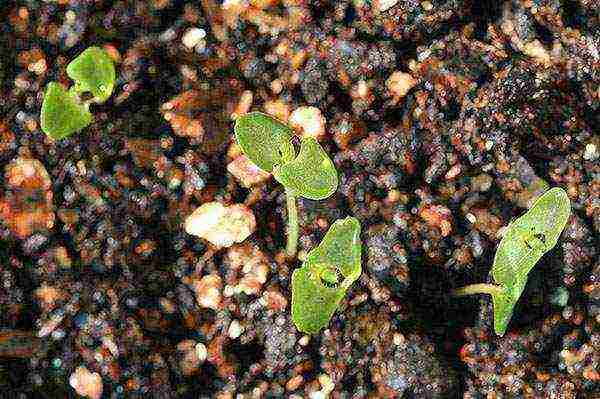 At the end of February or in March, when the period of stratification ends, seeds are sown on the surface of a mixture of fertile garden soil and sand. It is useful to pre-sterilize the substrate and sort out large inclusions.
At the end of February or in March, when the period of stratification ends, seeds are sown on the surface of a mixture of fertile garden soil and sand. It is useful to pre-sterilize the substrate and sort out large inclusions.
The crops are sprinkled with a thin layer of sand and placed in a home greenhouse. Germination takes place in the light at a temperature of 17–22 ° C. To maintain moisture, the soil is periodically sprayed with warm water, and to avoid the appearance of mold, the container is ventilated. The first shoots should be a signal that the plants need additional lighting. When the seedlings get stronger, they are dived, seated at a distance of 5 centimeters.
It is convenient to use peat pots before planting lavender in the ground. In them, the plants develop well, their roots are protected from decay and do not suffer during transfer to the garden.
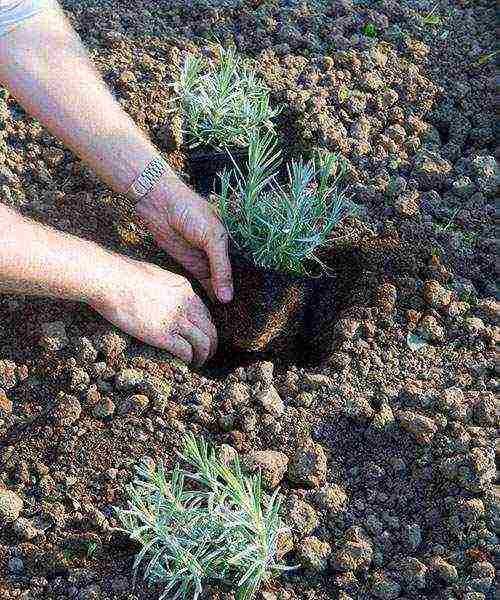 At the end of May, it is time for planting in the ground and caring for lavender in the Moscow region. For plants, choose dry, ventilated and well-lit places, the soil on which has a pH level of no higher than 6.5-7.5. The site is dug on a bayonet, simultaneously bringing in peat, humus and, if necessary, dolomite flour, loosening the ground.
At the end of May, it is time for planting in the ground and caring for lavender in the Moscow region. For plants, choose dry, ventilated and well-lit places, the soil on which has a pH level of no higher than 6.5-7.5. The site is dug on a bayonet, simultaneously bringing in peat, humus and, if necessary, dolomite flour, loosening the ground.
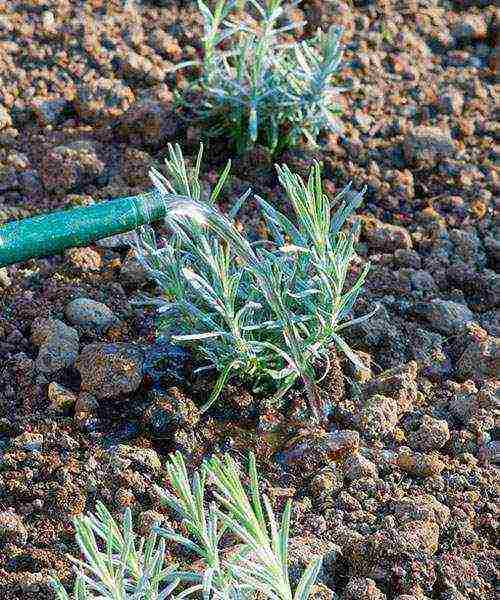 Seedlings are carefully transplanted, leaving at least 70-90 cm of free space between the plants, it will definitely come in handy for the growing bushes. During planting, the tillering point is slightly deepened, then the soil is compacted and thoroughly shed.
Seedlings are carefully transplanted, leaving at least 70-90 cm of free space between the plants, it will definitely come in handy for the growing bushes. During planting, the tillering point is slightly deepened, then the soil is compacted and thoroughly shed.
Autumn sowing of lavender is practiced only in the southern regions, where the seeds do not freeze, and immature sprouts can, without fear of spring cold, immediately grow. After planting the seeds in the ground, the beds are watered, and with the first frost they are abundantly covered with snow.
Planting lavender in the ground with cuttings, parts of a bush and layering
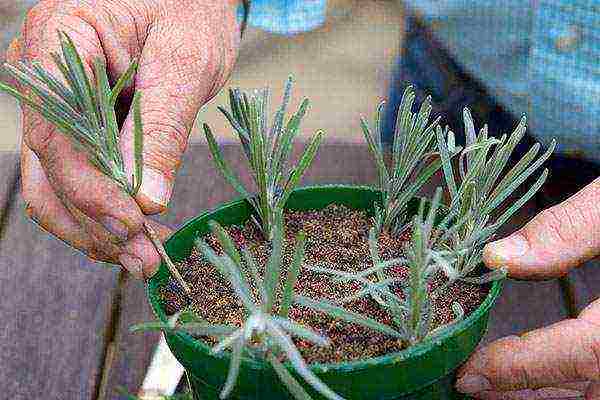 If there is an adult plant on the site, you can:
If there is an adult plant on the site, you can:
- divide it, getting seedlings with growth points and a root system;
- get cuttings that, after rooting, are easy to plant in the ground;
- create conditions for the formation of stem layering.
The lavender bush intended for dividing is carefully spud before wintering, and the shoots are cut off at a height of 10 centimeters. In spring, hilling is repeated, stimulating the formation of young shoots. A bush prepared in this way is dug up in the fall and divided into independent parts.They immediately plant lavender in the ground, in the fall the plant has time to acclimatize and prepare for winter.
In spring and summer, lavender shoots are used for cuttings. 8-10 cm pieces of stems are planted in wet sand, deepening by 2-3 cm. In the greenhouse, over the summer, cuttings form roots. With further home care for lavender, planting it in open ground is carried out in May or early June.
To obtain layering, selected strong shoots in the spring are tilted to the ground and buried in, securing them with a metal hairpin at a depth of several centimeters.
During the summer, the cuttings are looked after by weeding the soil nearby and watering the root formation sites. In the fall, such seedlings are separated from the mother bush and planted in a permanent place in the garden.
Taking care of lavender after planting outdoors
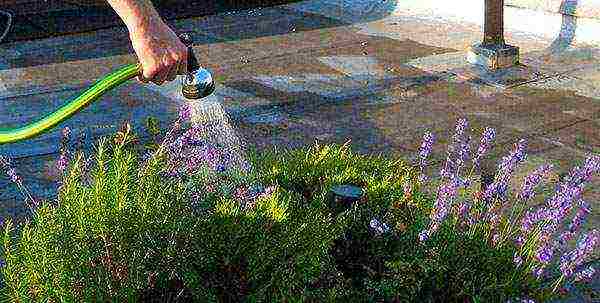 Lavender is planted for its fragrant blue-purple flowers. But on young plants in the first year of life, all the buds are cut off without waiting for flowering. This will strengthen the open field planting of lavender and make it easier and more effective to care for them. Throughout the life of the bushes, they must be weeded and watered.
Lavender is planted for its fragrant blue-purple flowers. But on young plants in the first year of life, all the buds are cut off without waiting for flowering. This will strengthen the open field planting of lavender and make it easier and more effective to care for them. Throughout the life of the bushes, they must be weeded and watered.
Lavender is a hardy crop, but it needs moisture to bloom. In hot weather, watering should be abundant and frequent.
Adult bushes form a dense dense cushion on the surface of the soil, so it is problematic to loosen the soil under them, but it is very important to keep the area around them clean. A layer of peat mulch will help to save moisture and airiness of the soil.
Spring-autumn hilling helps to maintain the density of the crown. It stimulates the formation of young shoots, gradually replacing aging branches. Pruning plants serves the same purpose. It is carried out after flowering and during it. For bushes aged 7-10 years, rejuvenating pruning is recommended, during which all shoots are shortened to 5 cm in length.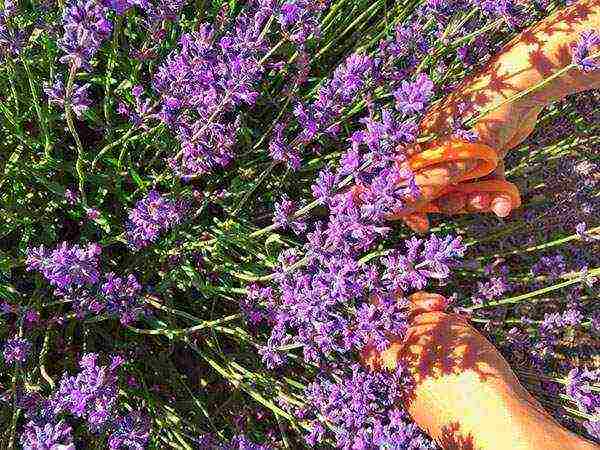
To fertilize lavender, mixtures with a predominance of potassium are used, which stimulates the formation of buds. Nitrogen is applied in moderation in the spring.
Southern crops, including lavender in Russian conditions, are at risk of freezing. To prevent this from happening, the bushes before frost are covered with spruce branches, non-woven material or other breathable types of protection that allow air to pass through, and then sprinkled with abundant snow.
Video about amazing lavender
Lavender is the flower that many associate with French Provence. Therefore, most gardeners grow lavender in order to get at least a little bit in this stunning place. This flower has its own characteristics that must be taken into account when growing and nursing outdoors. And then lavender will look luxurious, smell great and delight you every day.
Lavender varieties
Lavender belongs to ornamental garden and park plants. It is an evergreen bush with small flowers that gather in single spikelets. Such a plant begins to bloom at the end of summer. His homeland is the Mediterranean. The shrub is unpretentious to the soil, frost-resistant, very fond of light and moisture. Flowers can be purple, white, blue and lilac. It doesn't matter where the gardener lives, in St. Petersburg or in the regions of Siberia, you can plant and care for lavender everywhere.
Today, there are more than 30 varieties of lavender. They all differ in color, shape, height. The most popular types:
back to content ↑ Narrow-leaved lavender
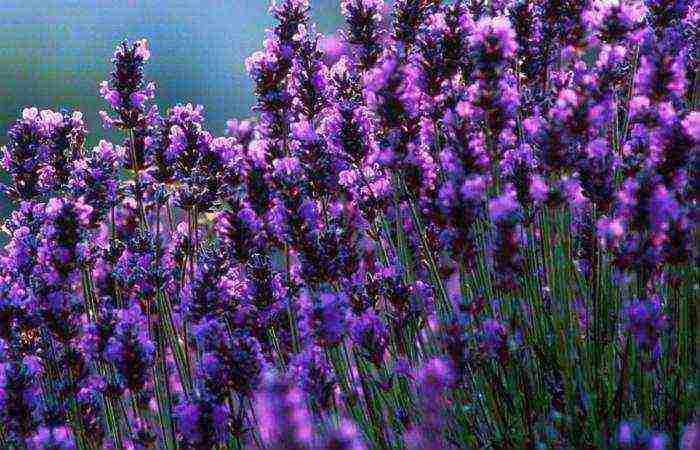
This species is also called in another way "English", "medicinal", "spikelet". It reaches 1 meter in height and width. The height of the peduncle is about 80 centimeters. Flowering teaches for June-July. It blooms with small flowers, which are collected in a brush. This species includes different varieties: Alba (white), Beechwoodblue (blue), Rose (pink), Jim and Hydecoat (purple). It is very difficult to grow and care for such a lavender variety in the Moscow region, since the conditions are very far from those of the Crimean ones.
back to content ↑ Dutch lavender

The bushes are up to 2 meters wide. The plant blooms for a limited amount of time - only in July. Famous varieties: Grosso, Saviers, Arabain Knight, Richard Gray.
back to contents ↑ Serrated lavender
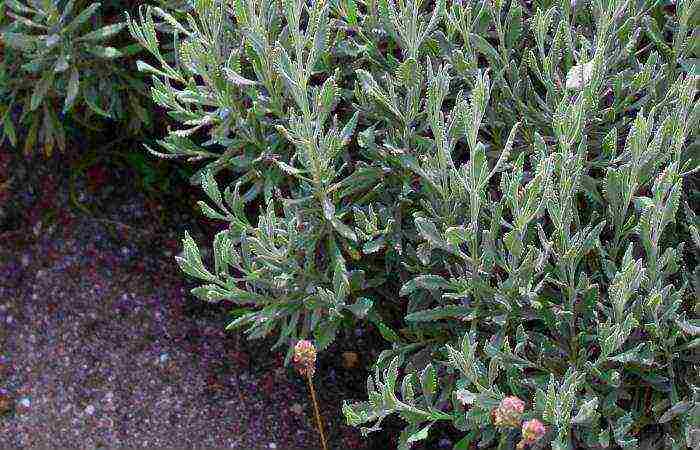
The leaves of this species are silvery, carved, and the flowers are large enough. The bush itself is very dense, reaching a height of only 30 centimeters. Usually this kind is grown at home, and such lavender becomes a houseplant.
back to content ↑ French lavender
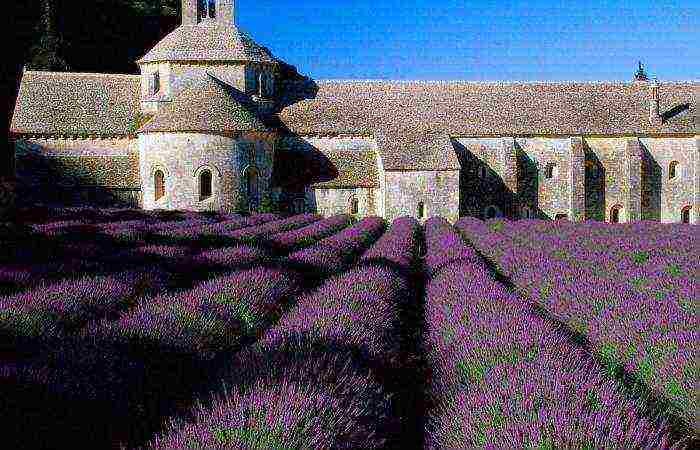
The bushes are voluminous, reaching a height of 1.3 meters. The leaves are large and the flowers are small. This type is very often chosen by designers to decorate hedges or borders along paths.
Many gardeners who live in the Leningrad region often plant and tend lavender. And any of the aforementioned species will grow well in this part of Russia.
back to content ↑ Planting with seeds
Despite the fact that lavender is considered an unpretentious plant, the process of planting seeds is not the easiest one. This method can only be used if you do not have the opportunity to buy seedlings for planting lavender. Lavender seeds must be stratified. Under the influence of low temperature and moisture, the seeds swell and then germinate better. This procedure can also improve immunity and protect against sudden changes in temperature in winter.
After that, you need to plant the seeds in a container. After a week, the container should be covered with glass or plastic wrap and placed in a warm room. Do not forget to moisten the soil with a spray bottle. Sprouts will gradually appear. The room temperature should range from 15 to 22 degrees Celsius. In this room, lavender will grow stronger until spring.
When the weather improves, the frosts will pass, and the soil warms up, the plants can be transplanted into open ground to a permanent place. Just don't count on blooming in the same year. Lavender will need almost a season to develop its root system and build up leaf mass.
back to content ↑ Planting by cuttings
The simplest and easiest way of propagation is considered to be cuttings. The procedure itself is no different from grafting other crops. You need to do the following:
- Cut off an annual shoot with a sharp knife;
- Cut it into cuttings;
- Prepare a suitable soil for them;
- Make a depression and plant 2-3 centimeters in the ground;
- Cover the seedling with foil and create a greenhouse;
- Water the plant in moderation regularly.
The cuttings take root very quickly. Then it will only be necessary to plant the lavender in the chosen permanent place in the garden, but at the same time, the planting scheme must be observed.
to the content ↑ Reproduction by dividing the bush
Many gardeners have shrubs that have been growing for several years, so they may resort to propagation such as dividing the bush. To do this, you need to do the following:
- Choose a strong and healthy bush;
- Cut off the upper shoots in the summer;
- Till the ground near the shoots;
- In the fall, you need to dig up the lavender and carefully divide it into two parts. This should be done with minimal damage to the root system;
- Separated plants should be planted in open ground on the same day.
back to content ↑ Plant care
When caring for lavender, first of all pay attention to watering. This is especially important for young plants. While the seedling is getting used to its new location, it should be watered almost every two weeks.
On hot days, the bushes should be watered more often, that is, once a week. Do not overmoisten the shrub, because this is also dangerous for the plant.
As far as top dressing is concerned, this is a very important aspect in growing garden lavender outdoors. It is carried out in several stages:
- In spring, lavender should be fertilized with nitrogen. To do this, prepare a solution of 10 liters of water and 2 tablespoons of sodium humate. Each bush takes 5 liters of the resulting solution;
- The period of budding and flowering.At this point in the life of lavender, every 2-3 weeks, the bushes are fed with a complex fertilizer with the addition of potassium and phosphorus;
- It is imperative to prune immediately after flowering. In the fall, they do a rejuvenating procedure that prolongs the life of your plant. Young shrubs should be spud in autumn and spring.
back to contents ↑ Preparing for winter
Most hobbyists think that cutting lavender for the winter is not worth it, but they are wrong. This procedure must be done without fail. With each passing year, the stems of lavender become harder and thicker. And if you carry out timely pruning, this will help the lavender not only rejuvenate, but bloom more luxuriant and thicker. Lavender can be left unshorn, but then the stems will be vulnerable to frost and strong winds.
Pruning lavender for the winter is a snap. It is necessary to remove those branches that have already bloomed for two seasons. The stem of each plant consists of a woody part and a green one. For the winter, it is worth cutting off the green part in the place where the shoot is 3 centimeters higher than the stiff part. Thanks to this, lavender will be able to calmly survive the winter.
Lavender, like any other plant that grows outdoors, needs additional protection during the winter. Shrubs can survive frosts down to -25 degrees. In the southern regions, such measures will not be necessary, since there usually does not happen a strong drop in temperature. But many gardeners play it safe and cover the bushes with a thick layer of snow. Lavender in the Urals can also be planted, but do not forget to cover it for the winter.
If lavender grows in the middle lane, it must also be covered for the winter. Usually covered with a wooden or plywood box. You can also cover it with spruce branches. It is not recommended to insulate shrubs with fallen leaves or straw. Because of these two materials, the bushes begin to rot and rot.
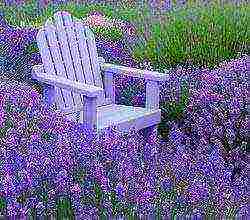 It is impossible to walk past the area where lavender grows. And the point is not even in the luxurious lilac bushes, but in the enchanting aroma that they spray around the neighborhood. And for a minute, frozen near this magic, you are already rushing home at full speed, elated. You need to find out as soon as possible: how capricious lavender plant is, are planting and care difficult, what is it sick of? After all, the fact that from now on it will be in your garden is a question that has already been resolved.
It is impossible to walk past the area where lavender grows. And the point is not even in the luxurious lilac bushes, but in the enchanting aroma that they spray around the neighborhood. And for a minute, frozen near this magic, you are already rushing home at full speed, elated. You need to find out as soon as possible: how capricious lavender plant is, are planting and care difficult, what is it sick of? After all, the fact that from now on it will be in your garden is a question that has already been resolved.
Description: varieties and varieties of lavender
Lavender is an evergreen, rather unpretentious plant widely used in cosmetology and medicine. The scent of lavender has a calming effect and helps relieve headaches. But not only medicinal properties are appreciated in lavender. It is widely used in perfumery and cosmetology. Lavender and cooking did not pass by, because this plant has a specific spicy taste. And in everyday life, dried lavender sprigs are used as a reliable remedy for moths.
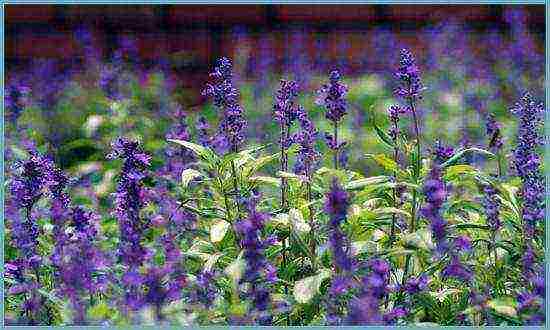
There are many varieties of lavender. Which one to plant in your garden - choose according to your taste
More than 25 types of lavender are known, but several varieties are most popular in the garden culture.
Narrow-leaved lavender (English). It is a bush no more than a meter in diameter. The leaves of this variety are medium-sized, narrow, gray-green. Blooms in June and July. The variety is unpretentious and tolerates low temperatures well.
Broadleaf lavender (French). This lavender variety is considered the ancestor of the decorative varieties. It differs from other varieties in a wide color range of inflorescences, as well as a very strong and not always pleasant aroma.
Hybrid lavender (Dutch). This variety is considered the largest. Its bushes can grow up to two meters. It is a natural hybrid of narrow-leaved and broad-leaved varieties. Blooms in July. Its frost resistance is lower than that of the narrow-leaved one. Refers to industrial grades.
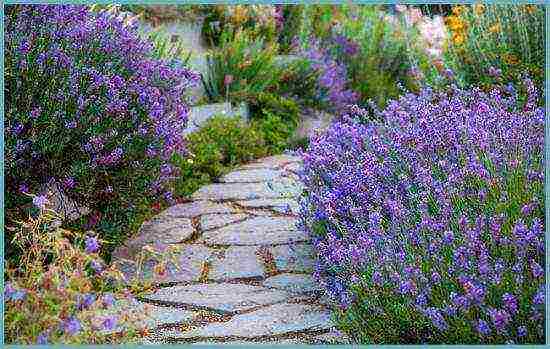
Dutch lavender has the most beautiful flowers
Lavender toothed. One of the most thermophilic varieties.Prefers to grow indoors rather than outdoors. It is the owner of soft silvery leaves and inflorescences of large flowers in all shades of purple.
Planting a plant
Lavender can be propagated in different ways: cuttings, dividing the bush, layering, seeds. Lavender seeds can keep germinating for many years, if you follow the rule: store them in sealed containers.
Attention! Lavender seeds need to undergo preliminary processing - stratification. For this, the seeds must be kept at a temperature of +5 ° C for at least two months. Most often, for this purpose, the seeds are mixed into wet sand and placed in a refrigerator.
Lavender seeds can be sown directly outdoors, but certain requirements must be followed.
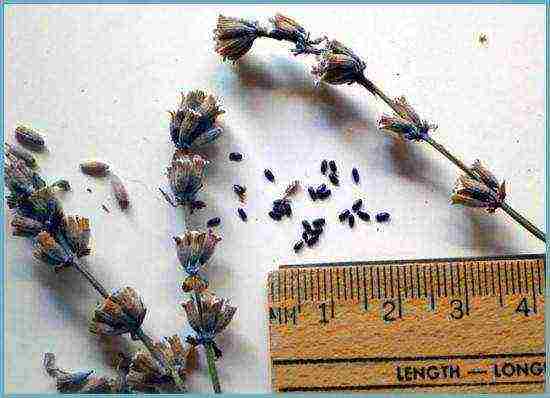
Lavender seeds
The best time to plant lavender outdoors is October. It is sown to a depth of no more than 4 mm, the soil must be slightly compacted. If the weather is dry, then the seeds can be watered. In winter, the area sown with lavender should be covered with snow as much as possible.
In open ground, you can sow seeds in the spring. To do this, first, in March, you need to remove the seeds in the refrigerator for stratification, and in May sow in open ground in a previously prepared place.
Advice. Choose a place for lavender in a dry and sunny area. This flower does not like waterlogging.
Lavender care
Water the lavender only when the soil is dry. Excessive moisture leads to root decay, but it is not recommended to dry out lavender either.
In autumn and spring, shrubs need to be hilled, and cutting lavender significantly extends the life of the plant. A small pruning can be done immediately after the lavender has faded, but a more significant shortening should be done only at the end of autumn, leaving up to 4-5 new green shoots.

Prune the bushes - this will not only give them a more decorative look, but also benefit the plant.
If your lavender will be hibernating outdoors where temperatures drop below -25 degrees, provide a warm shelter. To do this, it will be enough to cut the bushes before wintering and cover them with branches of coniferous trees.
Attention! Covering lavender with foliage, as is usually done to protect plants from freezing, should not be, this may result in plant decay.
Fertilizing and feeding lavender
In spring, it is recommended to feed lavender with nitrogen fertilizers. To do this, you need to dilute 1 tbsp. l. urea or 2 tbsp. l. "Sodium humate" for 10 liters of water. The consumption of such a solution for 1 bush should be no more than 5 - 6 liters.
At the beginning of flowering, lavender can be fed with a fertilizer solution "Agricola-Fantasy" (it is diluted in a proportion of 2 tablespoons per 10 liters of water). The consumption of this solution is 3-4 liters per one bush.
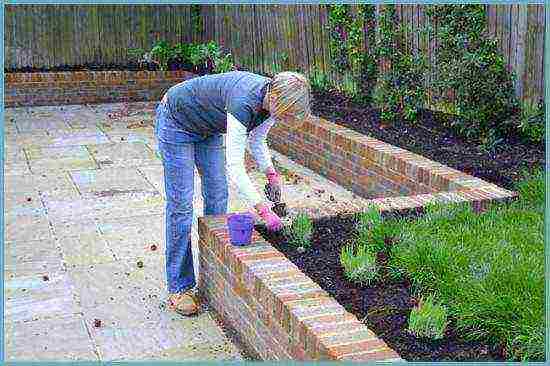
To make lavender bloom better - feed the plant with mineral fertilizers
Instead of Agricola, they also use a solution of organic fertilizer Rossa Universal, dissolving 2 tbsp. spoons in 10 liters of water. And the third option for feeding: 2 tbsp. l. dilute nitrophosphate and half a liter of liquid mullein in 10 liters of water. The consumption of the last two solutions is 10 liters per bush.
Plant propagation
Lavender is propagated by division, cuttings or layering.
Reproduction by division perhaps when there are already lavender bushes on the site. In summer, lavender produces a lot of young growth. It is something that can be rooted. To do this, you need to cut the plant and huddle in such a way that all the free space between the stems is densely filled with earth. And by the fall, the bush can be divided.
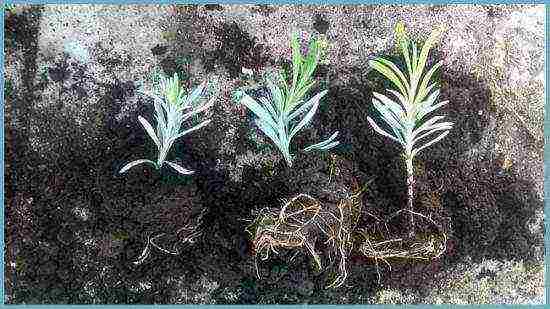
Dividing the lavender bush
The most suitable way to propagate home-grown lavender is propagation by cuttings... To do this, lignified annual shoots should be divided into cuttings no more than 10 cm and root.
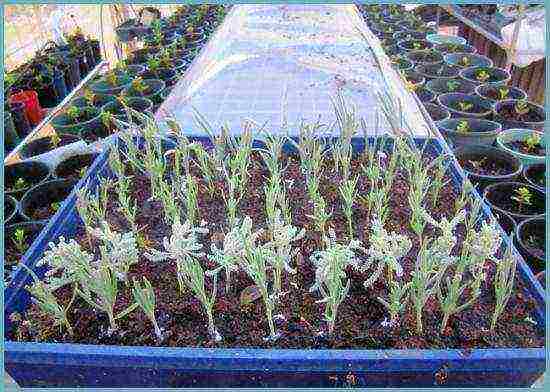
Propagation of lavender by layering
The easiest breeding method, which is suitable even for novice gardeners, is reproduction by layering... With this method, in the spring, 2-3 shoots are carefully folded back and placed in a groove 3-5 cm deep, fixed, sprinkled with earth and watered. These shoots need to be watered a little more abundantly in order for the formation of lateral roots to occur successfully. After a year, the shoots are already completely independent, and you can plant them from the mother bush.
Diseases and pests
Lavender is not very susceptible to diseases, and parasites attack it infrequently, but this does not mean that nothing like this can happen. Of the diseases, gray rot is most common. Caring for a diseased plant consists in cutting off the damaged parts. The cut off parts must be burned.
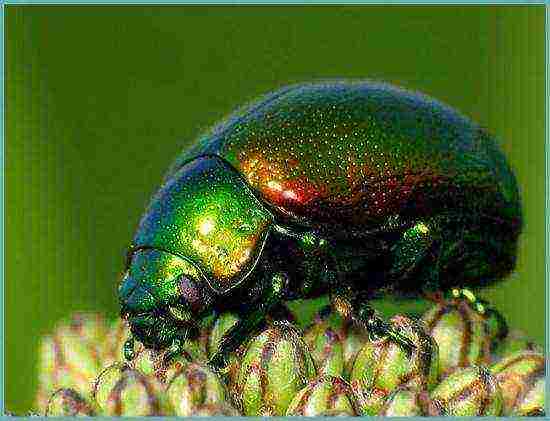
Monitor plant health and remove insects
From garden pests on lavender, you can find a rainbow beetle eating leaves. You need to collect it from plants by hand. But more often lavender is prone to the dominance of pennies, which do not cause any damage to the plant, but spoil the appearance pretty much, because they cover their larvae with a layer of white foam, which looks very much like saliva. Caring for lavender that has been attacked by pennies is very simple. It is enough to rinse off the foam with a stream of water.
Lavender: Combination with other plants
It is known that smells have a great influence on a person's subconsciousness. Therefore, when growing flowers, it is important that the flower bed is not only pleasing to the eye, but also enchants with its aroma. When planting plants, it is important to take care not only that the appearance of the flowers complements each other, but also that the floral aromas do not mix. This means that you will have to carefully consider the selection of flowers that you want to plant, otherwise you will hardly be able to rest or recharge in your garden.

Lavender looks very good next to plants with contrasting colors.
Lavender goes very well with sage and catnip. She also looks amazing next to yarrow and garden hydrangea, liatrix, or surrounded by grown herbs and perennials.
Lavender in landscape design
Lavender, planting and caring for which is so easy that any budding gardener can handle it, is ideal for decorating an area. A significant advantage of lavender among other landscaping plants gives a bright and intense color in various shades, from pale pink to bright lilac. This makes it possible to accentuate the grace of any corner of your garden.
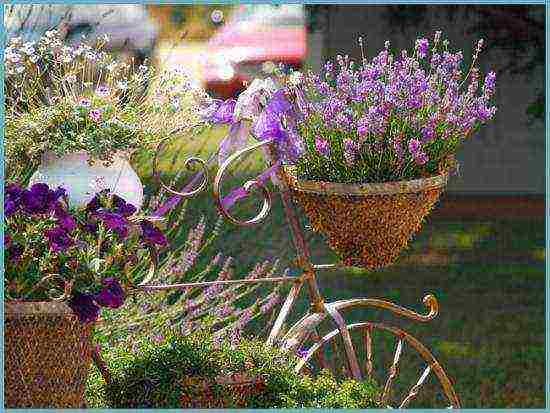
Lavender in landscape design
Advice. Use decorative designs to highlight the originality of your flower garden.
There are several options for decorating your garden with these flowering shrubs.
- Perhaps the most well-known and common way is to plant lavender along paths and sidewalks. This design of your site makes it possible to visually limit, as well as create a clear division of the garden into zones.
- The second option is to plant the bushes in such a way that the lavender will grow in accordance with the order of the cells on the chessboard. But this type of landing will only work on a completely horizontal surface.
- Another unusual way to emphasize the originality of a garden plot or flower garden is to form a "carpet" of these shrubs. If you decide to choose this option, you need to immediately determine the height of the lavender and regularly cut it at this level in the same plane. Such a carpet will not become a semblance of a soft grassy one on which you can comfortably sit, but planting shrubs in this way will allow lavender to brilliantly show its color.

Lavender is often planted along paths and fences.
Of course, lavender in landscape design is not as common as planting roses or all kinds of loaches, but this is what will emphasize the uniqueness and originality of the decorative design of your garden.
Growing lavender is the perfect way to highlight your garden or flower garden with color, shape, and an elegant fragrance that will impress everyone who walks by.
How to plant lavender correctly: video
Lavender in the garden: photo

